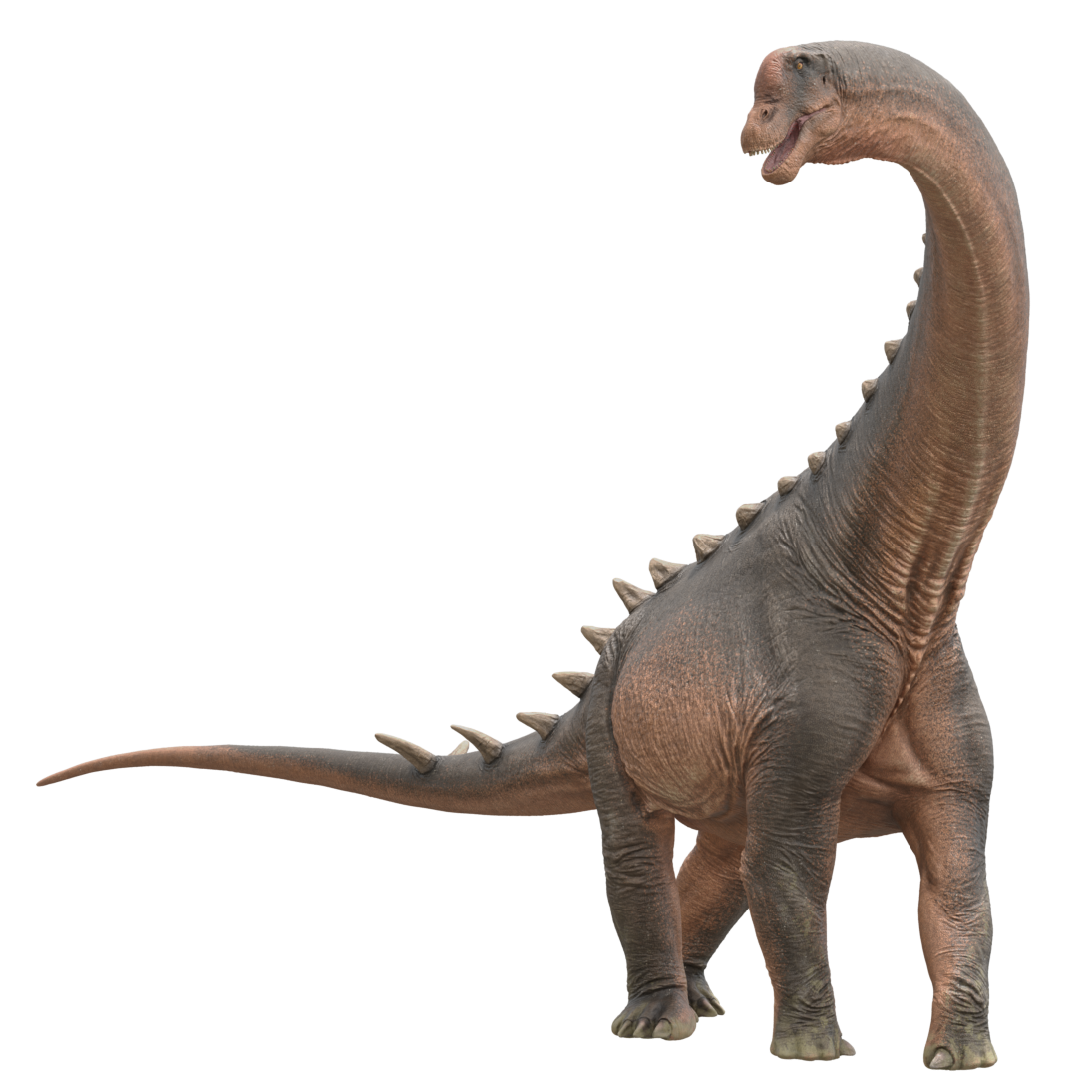The Last Titan of North America
Alamosaurus lived at the tail-end of the Age of Dinosaurs and may have been the heaviest animal to ever roam North America, possibly weighing up to 80 tonnes - as much as 15 African Elephants!
Overview:
In the Late Jurassic and Early Cretaceous, sauropods were the dominant herbivores in North America. But as the Early Cretaceous began to draw to a close, sauropods began to dwindle in North America until in the early Late Cretaceous, they vanished. For 30 million years in the Late Cretaceous, North America was sauropod-free. Smaller ornithischian dinosaurs such as hadrosaurs, ankylosaurs, and ceratopsians filled the herbivore niches. Why sauropods disappeared is still unclear, but it may have been in part due to competition with these smaller herbivores, or it may have had to do with habitat loss resulting from the formation of the Western Interior Seaway. Whatever the cause, sauropods became conspicuously absent from North America while they remained a major force in other ecosystems around the globe. But around 70 million years ago, ecosystems collided. South America, which had been separated from North America for millions of years, became close enough that animals could travel between the continents, perhaps by island hopping. A drop in sea levels toward the end of the Cretaceous may have aided these migrations. Hadrosaurs migrated into South America, and the ancestors of Alamosaurus, a titan that may have weighed over 80 tons, migrated into North America. The sauropods were back in North America, and bigger than ever before.
Discovery:
Alamosaurus was discovered in 1921 by Charles Whitney Gilmore, John Bernard Reeside, and Charles Hazelius Sternberg at the Naashoibito Member of the Ojo Alamo of New Mexico. While Alamosaurus remains would later be found in Texas in the Black Peaks, El Picacho, and Javelina Formations, Alamosaurus was not actually named after the famous Alamo in Texas, but rather after the geologic formation in which it was originally discovered. It has also been found in the North Horn Formation of Utah, and possible, though as yet undescribed, Alamosaurus remains have been discovered in the Evanston Formation of Wyoming. Currently, Alamosaurus is the only sauropod known from Late Cretaceous North America.
Evolution:
There has been some debate as to where Alamosaurus came from, though all researchers agree that it is a member of a clade of sauropods called Titanosauria. First appearing in the Early Cretaceous, titanosaurs soon spread across the globe, and were the only clade of sauropods that survived into the Late Cretaceous. The Titanosaurs included the largest known dinosaurs, like Patagotitan and Argentinosaurus. The debate with Alamosaurus is which group of titanosaurs it descended from. Some posit that the ancestors of Alamosaurus migrated north from South America, a hypothesis called the “Austral Immigrant Scenario”. North and South America weren’t fully connected at the time, but shallow seaways and islands could have allowed the migration to happen via “island hopping”. And about the same time that Alamosaurus appears in the fossil record of North America, hadrosaurs, previously unknown in South America, appear on the southern continent, implying a faunal interchange between the two Americas at the beginning of the Maastrichtian Age of the Late Cretaceous. Others think Alamosaurus had Asian ancestry, crossing into North America via the Berring Land Bridge, which existed at the time. However, it is thought that sauropods would not have been well-adapted for the cold temperatures of these higher latitudes, making it unlikely for them to have crossed the Berring Land Bridge, and the fossil record of Alamosaurus is limited to the southern half of Laramidia (western North America), supporting the south to north origin. An additional hypothesis is that Alamosaurus belongs to a clade of North American titanosaurs, which would also imply that the Sauropod Hiatus never happened. This, however, lacks any physical evidence. The Austral Immigrant Scenario is currently the most accepted hypothesis of the origin of Alamosaurus. It may be a close relative of the South American titanosaur Pellegrinisaurus.
Description:
If there’s one thing we know for sure about Alamosaurus, it’s that it was big. Really big. In fact, it may have been the largest land animal to ever inhabit North America. While it may not have been as tall as the Early Cretaceous Sauroposeidon and it certainly wasn’t as long as the Late Jurassic Supersaurus, Alamosaurus likely weighed between 38-80 metric tons (42-88 short tons), making it the heaviest North American sauropod, and heaviest North American land animal, ever discovered. A common humorous phrase is “everything is bigger in Texas”. In this case, that is correct! Though as stated previously, Alamosaurus didn’t only live in Texas. Alamosaurus was between 26 and 30 meters (85 and 90 ft) long, and like Brachiosaurus and many other titanosaurs, it may have held its head high above the ground like a gigantic giraffe. Its teeth were peg shaped, and poorly suited for chewing, so instead, like other sauropods, Alamosaurus would have swallowed its plant matter whole and relied on its massive gut to aid digestion via fermentation. They may have also swallowed stones, called gastroliths, to help grind their food in their stomachs, though no direct evidence of gastroliths has been discovered for Alamosaurus. Like most sauropods, Alamosaurus’s primary defense against predators would have been its gargantuan adult size, but like some other titanosaurs, including the South American Saltasaurus, Alamosaurus had another defense: armor. Alamosaurus was at least partially covered by armored plates in the skin made of bone covered with keratin, called osteoderms. These are the same type of structure that covers the backs of modern crocodilians and gives them extra protection from predators or competitors. Alamosaurus’s armor would have proved especially useful. Its South American ancestors would have had to fend off attacks from abelisaurs like Carnotaurus, and Alamosaurus itself lived in the range of the most fearsome and famous dinosaur predator of all, Tyrannosaurus rex.
Behavior and Ecology:
Alamosaurus lived in what is now the southwestern United States. Back then, this region was probably a fluvial (river) dominated semi-arid floodplain environment. To the west were the Sevier and Laramide mountains (major components of what are today called the Rocky Mountains) and to the east lay what was left of the receding Western Interior Seaway. Alamosaurus shared this environment with a variety of smaller herbivores. “Duck-billed” hadrosaurs, horned and frilled ceratopsians, and armored ankylosaurs were all present. The huge size of Alamosaurus as well as its status as the only sauropod in North America may have helped it avoid competition with these smaller herbivores. While all the others were competing for the food closer to the ground, Alamosaurus likely had the treetops all to itself. Predators also inhabited southern Laramidia. Small deinonychosaurian predators like Troodon and the dromaeosaur Dinobellator would have posed no threat to an adult or even a juvenile Alamosaurus, though hatchlings may have been at risk. The giant pterosaur Quetzalcoatlus also lived in the area, and like the raptors, they may have preyed upon Alamosaurus hatchlings. The top predator of Maastrictian Laramidia was of course Tyrannosaurus rex. Most T. rex have been found in what is now the northern United States, but it has also been found in the Southwest. T. rex is known from the North Horn Formation of Utah which has also produced Alamosaurus bones, and footprints and potential remains from New Mexico, Texas, and Mexico suggest the "Tyrant Lizard King" was king in the south just as it was in the north. We do not know if T. rex hunted Alamosaurus, but it was certainly a possibility where their ranges overlapped. It is not likely a healthy adult Alamosaurus would have had much to fear from any predators, even T. rex, but immature individuals may have been at risk from the enormous predator’s voracious appetite, and T. rex would have gladly scavenged dead or dying Alamosaurus as well. Perhaps young Alamosaurus congregated into herds for extra protection like many other herbivores, both past and present, are known to do.
Extinction and Legacy:
Despite Alamosaurus’s apparent success in southern Laramidia, the return of the sauropods to North America was doomed to be short-lived. 66 million years ago, an asteroid twice the size of Mt. Everest smashed into the edge of the Gulf of Mexico, causing the Cretaceous-Paleogene (K-Pg) Extinction which resulted in at least 75% of all species vanishing in a geologic instant. Most famous of the casualties were the non-avian dinosaurs, including the mighty Alamosaurus. Because Alamosaurus lived in southern Laramidia, they may have tasted the worst of the blast, and likely didn’t survive past the very day the asteroid hit, potentially perishing in a catastrophic firestorm that cooked them where they stood if they couldn’t find cover, which would have been difficult for an animal so large. If any did somehow survive the initial destruction, they would have quickly starved to death as the heat of the impact and the ejected material falling back to earth also ignited forest fires and left the world, and especially North America, a scorched wasteland. Now all that is left of these last of the titans is bones. You can see an Alamosaurus skeletal reconstruction mounted at the Perot Museum in Dallas, TX. And through artistry and technology, Alamosaurus has been resurrected on television, including in the acclaimed documentary Prehistoric Planet narrated by Sir David Attenborough.
Alamosaurus FAQ
Alamosaurus size / How big was an Alamosaurus?
See height, weight, and length.
Alamosaurus height / How tall was Alamosaurus?
Though its exact height is unknown and depends on its neck posture, Alamosaurus may have been around 12 meters (39 ft) tall!
Alamosaurus weight / How much did an Alamosaurus weigh?
Alamosaurus weighed between 38-80 tonnes (42-88 US tons), or roughly about the same as 7-15 elephants!
How long was Alamosaurus?
Alamosaurus was between 26 and 30 meters (85 and 98 ft) long!
What did Alamosaurus eat?
Alamosaurus ate plants, possibly browsing on trees.
Did T-rex eat Alamosaurus?
Probably. Both T-rex and Alamosaurus lived alongside each other in some areas. However, no definitive evidence of T-rex predation on Alamosaurus is currently known from fossils. Nevertheless, as T-rex was the top predator of the region, it almost certainly ate Alamosaurus at least occasionally, perhaps hunting juveniles or scavenging already dead Alamosaurus, though healthy adult Alamosaurus were probably too big for even T-rex to hunt!
What is Alamosaurus’s closest living relative?
Like all dinosaurs, the closest relatives of Alamosaurus are the only surviving lineage of dinosaurs today, the birds. Crocodilians, while not dinosaurs themselves, are also more distant cousins of dinosaurs.
Alamosaurus family members / Alamosaurus family / What kind of dinosaur was Alamosaurus?
Alamosaurus was a sauropod (“long-necked dinosaur”) in the subgroup Titanosauria and the family Saltasauridae.
Where did Alamosaurus live? / Where was Alamosaurus found?
Alamosaurus lived in the southern portion of Laramidia (western North America) and has been found in New Mexico, Texas, and Utah.
When did Alamosaurus live?
Alamosaurus lived about 70-66 million years ago at the end of the Cretaceous Period.
What does Alamosaurus mean? / Alamosaurus name meaning
Alamosaurus means “Ojo Alamo Lizard”.

